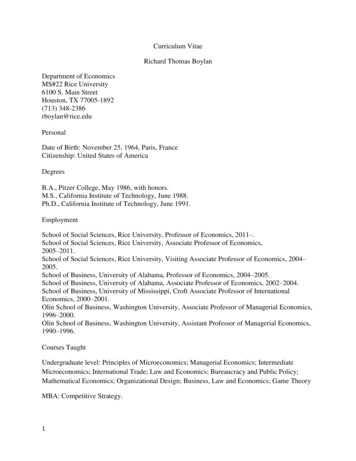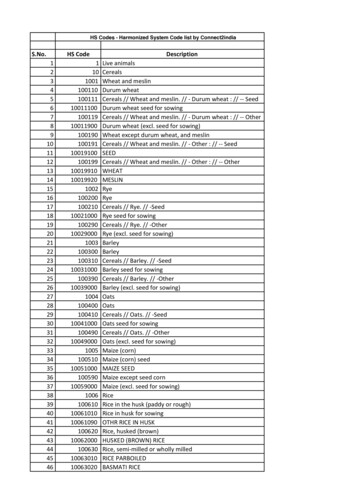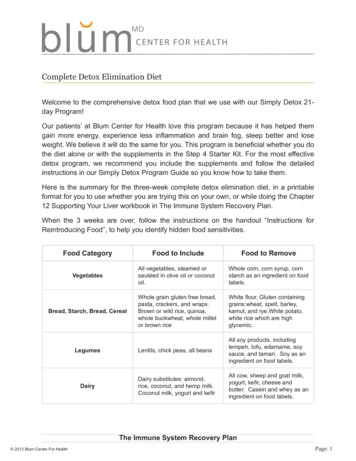
Transcription
Active and Intentional AdvisingPresented by: Carly Rice
Learning Outcomes¡ Identify the 5 Dysfunctions of a Team (Lencioni,2010)¡ Identify the 4 types of situational leadership(Hersey, Blanchard, and Johnson, 2001)¡ Apply the 4 types of situational leadership toeach of the 5 dysfunctions when advising astudent organization
5 Dysfunctions ofa Team(Lencioni, 2010)
Absence of Trust¡ What do teams/groups wholack trust look like?¡ Conceal weaknesses andmistakes¡ Don’t provide constructivefeedback¡ Hold grudges
Fear of Conflict¡ What do teams/groups whofear conflict look like?¡ Have boring meetings¡ Ignore controversial topicsthat are crucial for success¡ Don’t tap into perspectivesor opinions of all teammembers
Lack of Commitment¡ What do teams/groups thatlack commitment look like?¡ Ambiguous priorities¡ Have lack of confidenceand fear of failure¡ Revisits discussions multipletimes
Avoidance of Accountability¡ What does a team/groupthat avoids accountabilitylook like?¡ When standards ofperformance differ amongthe team, resentment cangrow¡ Encourages mediocrity¡ Misses deadlines
Inattention to Results¡ What does a team/groupthat doesn’t pay attentionto results look like?¡ Fails to grow¡ Achievement orientedmembers are checked out¡ Easily distracted¡ Individual goals vs. teamgoals
Pair/Share¡ How do you see these dysfunctions manifest inthe groups you work with?
SituationalLeadership Model(Hersey, Blanchard, and Johnson, 2001)
What is Active Advising?
Situational Leadership Model¡ Based on analyzing:¡ Ability¡ Willingness
Case Studies¡ You have a weekly program and students havedivided the responsibilities among themselves.Two weeks in a row, a few students do not showup for their shifts. Each student claims that it wassomeone else’s responsibility to show up for theweeks they missed.¡ What dysfunctions might be present in thisgroup?¡ What advising strategies could be used withthese students to address the issues?
Case Studies¡ A group of orientation leaders ranging fromincoming sophomores to incoming seniors isbeginning orientation season with a training.¡ At the training, the students are starting to breakup into cliques and start gossiping about oneanother resulting in conflict within the group.¡ What dysfunctions might be present in thisgroup?¡ What advising strategies could be used withthese students to address the issues?
Case Studies¡ Your students are tasked with planning a week ofevents for the university. Each student is assigneda different day of the week to program. Thestudents do not communicate with each otherthrough the planning process resulting ininconsistent marketing, low-attendance atevents, and the programming lacked cohesion.¡ What dysfunctions might be present in thisgroup?¡ What advising strategies could be used withthese students to address the issues?
Application!¡ Split up into 5 groups¡ Each group will be assigned a dysfunction of ateam¡ As a group, answer the following questions on yourgiant post it:¡ What are ways your dysfunction manifests itself in agroup of students?¡ What are strategies to combat the dysfunction?¡ What challenges do you face as an advisor with thedysfunction?
Questions?
Contact Information¡ Carly Rice, Program Coordinator for CarolinaProductions and Carolina After Dark¡ ricecs@mailbox.sc.edu
References¡ Hersey, P., Blanchard, K. H., & Johnson, D. E.(2001). Management of organizational behavior:Leading human resources. 8th ed. Upper SaddleRiver, NJ: Prentice Hall.¡ Lencioni, P.M. (2010). The five dysfunctions of ateam. New York: Wiley-Blackwell.
The FIVE Dysfunctions of a TeamMembers of dysfunctional teams Dysfunctionsand ways to Overcome each oneInattention toStagnates/fails to growRarely defeats competitorsLoses achievement-oriented employeesEncourages team members to focus on their own careers andindividual goalsIs easily distractedCreates resentment among team members who have different standardsof performanceEncourages mediocrityMisses deadlines and key deliverablesPlaces an undue burden on the team leader as the sole source ofdisciplineCreates ambiguity among the team about direction and prioritiesWatches windows of opportunity close due to excessive analysis andunnecessary delayBreeds lack of confidence and fear of failureRevisits discussions and decisions again and againEncourages second-guessing among team membersHave boring meetingsCreate environments where back-channel politics and personal attacksthriveIgnore controversial topics that are critical to team successFail to tap into all the opinions and perspectives of team membersWaste time and energy with posturing and interpersonal riskmanagementConceal their weaknesses and mistakes from one anotherHesitate to ask for help or provide constructive feedbackHesitate to offer help outside their own areas of responsibilityJump to conclusions about the intentions and aptitudes of otherswithout attempting to clarify them.Fail to recognize and tap into one another’s skills and experiences.Waste time and energy managing their behaviors for effectHold grudgesDread meetings and find reasons o avoid spending time together999Public declaration of resultsResults-Based rewardsSetting the tone for a focus on resultsfrom the leaderAvoidance of99999AccountabilityPublication of goals and standardsSimple and regular progress reviewsTeam rewardsAbility of leader to allow the team to serve asthe first and primary accountabilitymechanismLack of9999CommitmentCascading MessagingDeadlinesContingency and Worst-case scenario analysisLow-risk exposure therapy9ConflictMining for conflictReal-Time PermissionPersonality style and Behavioral PreferencetoolsDemonstration of restraint by leader whenpeople engage in conflictAbsence of999999Members of trusting teams . Retains achievement-oriented employeesMinimizes individualistic behaviorEnjoys success and suffers failure acutelyBenefits from individuals who subjugate their own goals/interests forthe good of the teamAvoids distractionsEnsures that poor performers feel pressure to improveIdentifies potential problems quickly by questioning one another’sapproaches without hesitationEstablishes respect among team members who are held to the samehigh standardsAvoids excessive bureaucracy around performance management andcorrective action Creates clarity around direction and prioritiesAligns the entire team around common objectivesDevelops an ability to learn from mistakesTakes advantage of opportunities before competitors doMoves forward without hesitationChanges direction without hesitation or guilt Have lively, interesting meetingsExtract and exploit the ideas of all team membersSolve real problems quicklyMinimize politicsPut critical topics on the table for discussion Admit weaknesses and mistakesAsk for helpAccept questions and input about their areas of responsibilityGive one another the benefit of the doubt before arriving at a negativeconclusion.Take risks in offering feedback and assistanceAppreciate and tap into one another’s skills and experiencesFocus time and energy on important issues, not politicsOffer and accept apologies without hesitationLook forward to meetings and other opportunities to work as a groupAbility of leader to not place too high of apremium on consensus or certaintyFear of999Resultsby Patrick LencioniTrustPersonal Histories ExerciseTeam Effectiveness ExercisePersonality and Behavioral Preference Profiles360-Degree FeedbackExperiential Team ExercisesDemonstration of vulnerability first by leader
The FIVE Dysfunctions of a Team by Patrick Lencioni Members of dysfunctional teams Dysfunctions and ways to Overcome each one Members of trusting teams . Ł Stagnates/fails to grow Ł Rarely defeats competitors Ł Loses achievement-oriented employees Ł Encourages team members to focus on their own careers and individual goals










